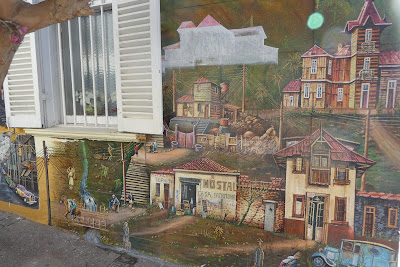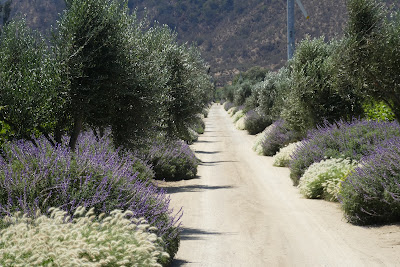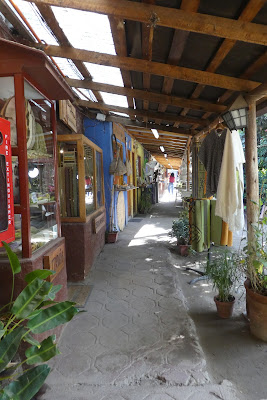 |
| The text on this plaque is below |
"Bunkers Hill was named after Captain Eber Bunker, father of
Australian whaling, who had his house and store not far from here in the early
1800s. This high ground, as outlined on
the map below, was commonly called Bunkers Hill until the 1830s, but only
received official recognition, at the request of the Sydney Cove Redevelopment
Authority, in 1977.
Captain Eber Bunker was born to a Puritan whaling family in
Plymouth, Massachusetts on 7th March 1761. He moved to England after the American
Revolution where he married Margrett Thompson, second cousin to Admiral
Collingwood, in 1786 and took his first command, the whaler “Spencer”, in
1788. He first arrived in Sydney in 1791
as master of the “William and Ann”, a transport in the Third Fleet, and there
upon engaged in the first whaling expedition in Australian waters in the
company of the “Britannia”.
He returned to Australia in 1799 with the new ship “Albion”
and spent two winters whaling of the Australian and New Zealand coasts. At the request of Governor King, he took
presents to King Pomere of Tahiti in exchange for hogs, howls and fruits for
the colony. On a second voyage from England in 1803 he discovered the Bunker
Islands off Queensland. The “Albion”
accompanied the “Lady Nelson” from Sydney with stores and cattle, to found the
new settlement of Hobart on the River Derwent, in Tasmania.
He was well rewarded for his services being given several
land grants around Liverpool and the Hunter Valley and, after his last whaling
voyage in 1824-25, he retired to his properties, dying at Collingwood (now part
of Liverpool) on 27th September 1836, aged 74.
You are standing on the high bluff that gave The Rocks its
name and which marks the eastern edge of Bunkers Hill. In front of you are the brickyards of Sgt.
Major Row (1881), the stone buildings of the Counting House (1848), and Union
Bond (1841) and below are the terraces of Atherton Place (1880 – 81). Behind you, in Cumberland Street are under
approaches to the Sydney Harbour Bridge, where Princes Street once lay, was the
site of the solid mansions of worthy and well-to-do citizens of the 1850s. Handsome homes of two or three storeys, with
thick walls of squared stone and wide verandahs with graceful iron columns rose
in grounds dotted with tall Norfolk Pines and Moreton Bay figs.
The Plague of 1900 led to a massive clean up of The Rocks
and many of the old houses were torn down by the government of the day. Work on the Harbour Bridge swept away much of
what remained.
The walkway and lookout on which this plaque stands were put
by the Sydney Cove Redevelopment Authority in 17979 – 80, transforming
Gloucester Street to Gloucester Walk.
This Plaque was unveiled by the Minister for Planning &
Environment the Hon. Eric Bedford BA MP on Wednesday 22nd October 1980."
------------------------------
These three photos were sent to me by a young genealogist friend
in Australia. He is applying for membership to the Mayflower Society under the passengers
John Howland and Elizabeth Tilley. The
new Australian Mayflower Society just formed a few months ago, and I wish him
luck! He is also a descendant of Eber
Bunker. Here is the lineage from John Howland
and Elizabeth Tilley down to Eber Bunker.
Generation 1: John
Howland, Mayflower passenger, son of Henry Howland and Margaret Aires, was born
1592 in Fenstanton, England, died 23 February 1672 at Rocky Nook, Plymouth,
Massachusetts; married on 25 March 1623 in Plymouth, Massachusetts to Elizabeth
Tilley, Mayflower passenger, daughter of John Tilley and Joan Hurst. She was born 30 August 1607 in Henlow, Bedfordshire,
England and died 21 December 1687 in Swansea, Massachusetts. They had ten
children.
Generation 2: Desire
Howland, born 13 October 1623 in Plymouth, Massachusetts, and died 13 October
1683 in Barnstable, Massachusetts; married on 6 November 1644 in Barnstable to
John Gorham, son of Ralph Gorham and Margaret Stephenson. He was born 28 January 1620 in Benefield,
Northamptonshire, England and died 5 February 1675 in Swansea. They had eleven
children.
Generation 3: Shubael
Gorham, born 21 October 1667 in Barnstable, died 7 August 1750; married on May
1695 on the island of Nantucket to Puella Hussey, daughter of Stephen Hussey (grandson
of Rev. Stephen Batchelder) and Martha Bunker (daughter of George Bunker and
Elizabeth Godfrey). She was born 10th
10 mo. 1677 on Nantucket, and died in Barnstable before 23 September 1748. They
had ten children.
Generation 4: Desire
Gorham, born 26 September 1710 in Barnstable, died 5 November 1801; married
Zachariah Bunker on 2 September 1728 on Nantucket island. He was the son of
Jonathan Bunker and Elizabeth Coffin.
Zachariah Bunker died on Nantucket 16 August 1757. They had nine children all born on Nantucket
island.
Generation 5: James Bunker, born 21 August 1733 on Nantucket
island, was lost at sea in 1768; married Hannah Shurtleff in Plymouth,
Massachusetts on 26 January 1757. She
was the daughter of James Shurtleff and Faith Jackson. They had five children.
Generation 6: Eber Bunker, son of James Bunker and Hannah
Shurtleff, was born on 7 March 1761 in Plymouth, Massachusetts and died on 27
September 1836 at Collingwood, now Liverpool, New South Wales. He married first
on 16 November 1786 in England to Margrett Thompson, daughter of Henry Thompson
and Isabella Collingwood, who died March 1808. They had children: Isabella, Mary Ann, Charlotte, Charles
Harris, Henry Edmund, Ernest, James Eber, and Henry Thompson. He married second to Margaret Macfarlane. He married third to Ann Howey, widow of
William Minchin on 28 April 1823.
You might be wondering if Eber Bunker of Bunkers Hill in
Australia is related to the same family of Bunker Hill in Boston
(Charlestown). The answer is “Probably!”.
The Bunker Hill in
Massachusetts was named for George Bunker, who had a farm there in Charlestown. The Bunker family lived on this land before
the battle, and for generations afterwards.
George left the area a few years before the Revolutionary War, which was
fortunate since the town of Charlestown was destroyed by the British during the
battle. The famous “Bunker Hill Monument”
is on the top of Breed’s Hill in Boston, not Bunker Hill.
George Bunker was born about 1600 at Bengeo, Hertfordshire,
England and died about 1664 in Malden, Massachusetts; married Judith Major on 8
September 1624 at Odell, Bedfordshire, England.
He owned the land known as Bunker Hill in Charlestown and is buried at
the Phipps Street Buring Ground in Charlestown.
His five children were baptized in Odell, Bedfordshire which is very
close to Tingrith (see below for the lineage of Eber Bunker). However George Bunker’s parents are unknown,
so we cannot prove that these two Bunker branches were kin. George Bunker’s last two children (he had
seven children) were baptized at Charlestown, Massachusetts.
 |
| Eber Bunker (1761 - 1836) |
Eber Bunker’s Bunker Genealogy:
Generation 1: Tymothie Bunker and Elizabeth Hawkins, resided
in Tingrith, Bedfordshire, England
Generation 2: George Bunker and Elizabeth Godfrey, 5 May
1644 in Maulden, Bedfordshire, England
Generation 3: William Bunker and Mary Macy
Generation 4: Jonathan Bunker and Elizabeth Coffin
Generation 5: Zachariah Bunker and Desire Gorham
Generation 6: James Bunker and Hannah Shurtleff
Generation 7: Eber Bunker of Australia
 |
| Isabella, daughter of Eber Bunker |
For the truly curious:
Bunker Family History by Henry L. Bunker III, 1984. [Information on Bunker Hill in Massachusetts
is on pages 69 – 70, 72, and 99 – 100].
Heather Wilkinson Rojo, "Eber Bunker's Hill in Australia, a Mayflower Descendant", Nutfield Genealogy, posted March 20, 2020, ( https://nutfieldgenealogy.blogspot.com/2020/03/eber-bunkers-hill-in-australia.html: accessed [access date]).











































